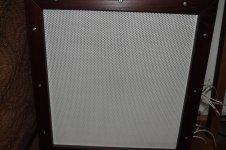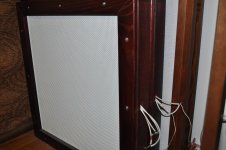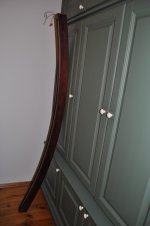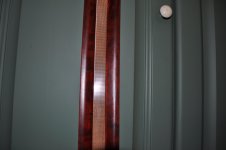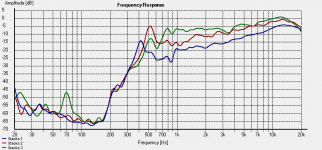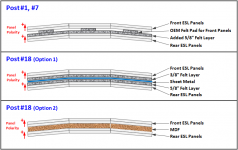That's right, this is an old video from 2015, with only one subwoofer and two narrow (20mm) but high (190cm) and vertically curved satellites in the middle and high frequencies.
But this summer I made parts for another subwoofer, or rather made the membranes themselves, because they needed a lot.
The size of the subwoofer is 59/50cm.
The diaphragm-stator gap is 3mm.
The sound of electrostatic subwoofer like this is not confused with any cone speaker cone with magnet and coil.
The project is not over yet, but before the summer is going to finish completely))).

I can't figure out how to insert photos here.
But this summer I made parts for another subwoofer, or rather made the membranes themselves, because they needed a lot.
The size of the subwoofer is 59/50cm.
The diaphragm-stator gap is 3mm.
The sound of electrostatic subwoofer like this is not confused with any cone speaker cone with magnet and coil.
The project is not over yet, but before the summer is going to finish completely))).
I can't figure out how to insert photos here.

You can insert pictures by using the advanced editor below the quick reply box, or clicking on the large "Post Reply' buttons on the top and bottom left of the thread. You'll be able to see an applet for managing attachments, and you can browse to your file location.
You'll have to attach them directly from your PC. Many image hosts and cloud servers have complex sharing settings, which means an image attached using the quick reply box may or may not appear.
Thanks for understanding.

Hi friends, I made isobaric bass panels consisting of 6 membranes and 8 stators made up of a package,they work very efficiently and dynamically. Diy ESL. - YouTube
WoW !!!

Very Nice, if those are ESL lows, I could really digg sittin' back and listening to Jaco's Bass with some Weather Report on those !!! 😀
This really inspires me to start making all of those extra panels now !!!
 😀
😀Cheers !!!

jer 🙂
Last edited:
Very nicely made.Moderator, thank you, I'll try it now))).
So are those panels separate assemblies stacked in front of each other in series? Is there 6 membranes and 8 stators in each one?
Thank you!WoW !!!
Very Nice, if those are ESL lows, I could really digg sittin' back and listening to Jaco's Bass with some Weather Report on those !!! 😀
This really inspires me to start making all of those extra panels now !!!😀
Cheers !!!
jer 🙂
But keep in mind that the stators should be of thick, perforated iron with an acoustic transparency of about 40%, the stators should not add their individual singing.
Thanks for the assessment!Very nicely made.
So are those panels separate assemblies stacked in front of each other in series? Is there 6 membranes and 8 stators in each one?
Yes, they are made a package to each other, but not all, and three membranes in each wooden case, and then these cases are connected. This is because at first I decided that for one channel three membranes connected by isobaric, but when there were two identical isobaric in front of me, I was tempted and combined them into one))), the effect was strong enough and I decided to make another such version for another stereo channel.
In the video that is above on YouTube-used one subwoofer, at that time the second was not yet available.
Are they sealed as one unit around the edges inside the frame? So actual isobaric configuration? Are they damped?
For my little experiment I will next add a solid sheet metal barrier between 2 layers of felt and seal each side of 3 panels against the frame. So there will be no interaction from front assembly with rear assembly and the felt filled cavity between them will act as a minimal 'box' so output will be restricted out the front of each side.
I do not yet have a mic so have not done any tests on REW. Have you?
I do not yet have a mic so have not done any tests on REW. Have you?
Last edited:
Are they sealed as one unit around the edges inside the frame? So actual isobaric configuration? Are they damped?
Yes, they are completely sealed.
Your experiment will be very interesting.For my little experiment I will next add a solid sheet metal barrier between 2 layers of felt and seal each side of 3 panels against the frame. So there will be no interaction from front assembly with rear assembly and the felt filled cavity between them will act as a minimal 'box' so output will be restricted out the front of each side.
I do not yet have a mic so have not done any tests on REW. Have you?
A little later I will also show you what the end result is🙂.
I have a couple more thoughts on the acoustic design of these subwoofers, but it will not be a box, I called it "floating" acoustic design))).
Last edited:
Oh i did not see this post, it is simliar as what i made a few years ago , although be it tweeters. meaybe its usefull for you experiments !
sandwich esl ?Yummie
multi membranes up to 5 i used,
Every doubling gives 6+- dB.
max spl remains the same.
membrane thickness add up ! so 4 1 micron foils act like a 4 micron +- slightly more to be honest
Resonance of the whole set goes up.
i used one tranformer and made 2 biases to make the foils play in phase i switched the bias voltage from - to plus ever other membrane. so for 2 stacks i only use 3 stators. since the back stator of the first panel acts like the fron stator of the next stack i need to change the bias to let the second foil move in the correct direction
you can do the same with bass panels
sandwich esl ?Yummie
multi membranes up to 5 i used,
Every doubling gives 6+- dB.
max spl remains the same.
membrane thickness add up ! so 4 1 micron foils act like a 4 micron +- slightly more to be honest
Resonance of the whole set goes up.
i used one tranformer and made 2 biases to make the foils play in phase i switched the bias voltage from - to plus ever other membrane. so for 2 stacks i only use 3 stators. since the back stator of the first panel acts like the fron stator of the next stack i need to change the bias to let the second foil move in the correct direction
you can do the same with bass panels
Attachments
Last edited:
Interesting, I always thought that isobaric is effective only where there is a diaphragm piston mode, and it is known to exist only in the low frequencies, in the upper frequencies the piston mode when the diaphragm is almost absent or it is vanishingly small.
its not actually isobarik, since mylar tends to be acoustically transparant when not being drive, the mylar moves so x max is xmax though. so all outputs just count up when all are driven
Ya gota love it when things like this happen.
Some advice from past experience with many lower mass planer magnetic protos ( mass on par with many stats not the typical higher mass planers).
1- you may get a similar result, (good damping of the diaphragm) with a single diaphragm arraignment with just a layer of much thinner felt or other restrictive medium on rear stator
These light diaphragms have resonance issues and a bit of restrictive material over most of the center area or more goes a long way to taming them. too much restriction however and the bass will be EQ down too much. Better than felt is simply a screen or thin cloth with the right resistance found by experiment and solidly attached to stator. Better if its not allowed to move.
2- I suspect the dual diaphragm arraignment helps most below about 150 hz by adding enough mass to "beef up" the response in that area. Very light diaphragms are damped by the mass of air around them in this region and adding another diaphragm is similar to doubling diaphragm mass at low freq without the colorations in the mids that thicker heavier diaphragm may have
so to sum up, my guess is that the mid and up perf. increase you hear is largely the damping from the felt AND a single diaphragm with thin restrictive material done just right will probably give similar result. In the bass region however the dual diaphragm may be responsible for a bit heftier perceived bass. All together the felt and dual diaphragm resulting in better dynamics and FR and a quiet background
Some advice from past experience with many lower mass planer magnetic protos ( mass on par with many stats not the typical higher mass planers).
1- you may get a similar result, (good damping of the diaphragm) with a single diaphragm arraignment with just a layer of much thinner felt or other restrictive medium on rear stator
These light diaphragms have resonance issues and a bit of restrictive material over most of the center area or more goes a long way to taming them. too much restriction however and the bass will be EQ down too much. Better than felt is simply a screen or thin cloth with the right resistance found by experiment and solidly attached to stator. Better if its not allowed to move.
2- I suspect the dual diaphragm arraignment helps most below about 150 hz by adding enough mass to "beef up" the response in that area. Very light diaphragms are damped by the mass of air around them in this region and adding another diaphragm is similar to doubling diaphragm mass at low freq without the colorations in the mids that thicker heavier diaphragm may have
so to sum up, my guess is that the mid and up perf. increase you hear is largely the damping from the felt AND a single diaphragm with thin restrictive material done just right will probably give similar result. In the bass region however the dual diaphragm may be responsible for a bit heftier perceived bass. All together the felt and dual diaphragm resulting in better dynamics and FR and a quiet background
Last edited:
reply above yours indiccates it also works up to 20 khz if you ask me. all depends on the distance membrane to mebrane ofcourse open area as well as mass.
I will do some tests with REW when I receive the umik-1 I ordered. But my non expert but well trained ears over 40 years tell me firstly that it's by far mostly damping. The amps are all in great shape and output does seem to be significantly greater so not sure how completely isolating both sets of panels with a solid barrier sandwiched in the felt will affect that. However the solid back will render the cavity like a sealed cabinet; I will seal the panels around their perimeter. So that will cause a back wave to project out the front increasing output. But, that may take all the magic away as now there's no more mechanical eq. from the other side. It's hard to say how much the other set may or may not be reinforcing response. It'll be interesting
its not actually isobarik, since mylar tends to be acoustically transparant when not being drive, the mylar moves so x max is xmax though. so all outputs just count up when all are driven
In my subwoofer, where there are 6 membranes of the pack-all of them work for sound pressure, not sound volume, that is, the first and last membranes have a connection with the surrounding space, but since the other membranes of the pack push them, giving the vibrations to these two membranes much more than these membranes could vibrate without the help of the other membranes, I decided to acoustically load these outermost membranes with additional passive membranes and thus the first and the last membranes of the pack will be closed from the outside by a couple more passive membranes, which will damp the first and the last membranes, and otherwise at high signal they will hit the stators.
I will see what will come out of it.
Theoretically, if these passive membranes are removed at some distance from the main membranes, it will be the volume of air attached to the subwoofer, that is partially perform the role of a box, but only "floating" and not rigid.
All correct except you've reversed option #1 and #2 in post 18. I have the 20awg sheet steel cut and ready but I'm going to wait for the Umik-1 I ordered so I can take measurements with and without. I don't think the MDF option is beneficial just logically? The sandwiched barrier will tell the tale, I think. I think I will lose the added output with the sandwiched barrier because technically, they are in fact isobaric at present. So I anticipate a loss of the FR and dynamic range enhancements also.
- Home
- Loudspeakers
- Planars & Exotics
- Isobaric ESL alternative
